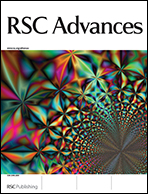Characterization of iron impregnated polyacrylamide catalyst and its application to the treatment of municipal wastewater†‡
Abstract
The persistent organic pollutants and bio diversities (pathogenic and non-pathogenic) present in treated municipal wastewater cause environmental deterioration besides adversely affecting human health. In the present investigation, an attempt was made to treat the municipal wastewater using iron impregnated polyacrylamide (IIPA) powder catalyst in a fluidized reactor. The IIPA catalyst was characterized by carbon, 12.23%, hydrogen, 1.63%, nitrogen, 2.93%, iron, 58%, silicon, 15.25%, surface area 96.66 m2 g−1 and pore diameter, 58.32 Å. IIPA was crystalline with an energy gap of 1.93 eV and it was capable of generating hydroxyl radicals for the oxidation of dissolved organics in municipal wastewater with minimum sludge yield (0.05 g VSS/g of COD). The oxidation of dissolved organics in municipal wastewater by IIPA was carried out under batch and continuous mode operations. The pseudo first order rate kinetic constants for the oxidation of organics in municipal wastewater were found to be 2.2 × 10−2, 3.01 × 10−2, 3.33 × 10−2 and 3.72 × 10−2 min−1. The activation energy for the oxidation of dissolved organics in municipal wastewater was 13.15 kJ mol−1. The pollution parameters BOD5, COD, ammonia, TKN and sulphide were removed from the municipal wastewater by 72.72%, 82.87%, 71.76%, 65.3% and 86.66% respectively.


 Please wait while we load your content...
Please wait while we load your content...